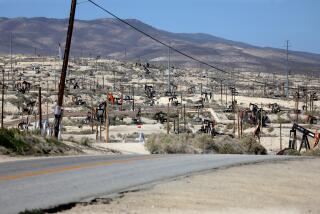Shipping Magnate Who Created Westlake Dies : Suburban: Daniel K. Ludwig was 95. In 1967, he began developing the area into one of nation’s first instant cities.
Daniel K. Ludwig, a fabulously wealthy shipping magnate who created the upscale suburban communities of Westlake and Westlake Village, has died at the age of 95, it was announced Friday.
Ludwig, who owned about 60 oceangoing vessels at the height of his shipping career and built the world’s first oil supertankers, died Thursday at his home in Manhattan, according to R. Palmer Baker Jr., executor of Ludwig’s estate.
Ludwig had been ill for some time and had not been active for five years, Baker said.
In addition to his shipping interests, Ludwig’s National Bulk Carriers Inc. invested in forest products, oil and gas, coal and other minerals, hotels and real estate and ranching and agriculture. The conglomerate had operations in 23 countries.
Forbes magazine estimated Ludwig’s fortune at $1.2 billion last October. The magazine, however, does not list him as one of the world’s billionaires in its current issue.
An extremely private man whose unauthorized biography was called “The Invisible Billionaire,” Ludwig was known personally to only a few residents of the suburban Los Angeles communities that he master-planned.
But the effect he had on the area was vast. In 1967, Ludwig’s American-Hawaiian Steamship Co. began developing 12,500 acres of ranchland straddling the Los Angeles County-Ventura County line into one of the nation’s first instant cities. The company itself owned about 5,000 acres.
With an artificial lake at its center, the community that stretched from Triunfo Canyon Road to Kanan Road in Ventura County was intended to appeal to city residents who wanted to escape to the country without leaving their urban amenities behind. It is now home to about 38,000, mostly well-to-do residents.
Ludwig’s company sold most of its holdings in the community in 1973 and 1974 to the Prudential Insurance Co., which then sold the land to developers to complete Ludwig’s plan.
Ludwig’s vision gave the community the nation’s first golf course lighted for evening play and a private man-made lake. To create the lake in 1967, Ludwig built what was then the world’s largest privately owned dam, according to Kenneth E. Rufener, one of the city’s first residents who now serves on the Westlake Village City Council.
Although residents disagreed with some of Ludwig’s development plans over the years, Rufener said he also inspired respect. “What Mr. Ludwig promised is exactly what we got, a very fine community,” Rufener said.
The Los Angeles County portion of Ludwig’s development incorporated in 1981 to become the city of Westlake Village. The Ventura County portion, substantially larger and known simply as Westlake, is part of the city of Thousand Oaks.
In the mid-1980s, Ludwig wanted to turn the 18-hole Westlake Village Golf Course into a nine-hole course and a business park. That inspired passionate opposition from many residents and two members of the Westlake Village City Council flew to New York to plead with Ludwig to back down.
Westlake Village Mayor Berniece E. Bennett said she explained to Ludwig that the community wanted him to give the golf course to the public but that he was unwilling to do so. “He said he was a philanthropist, and that when he died his money would go to cancer research, but until then he wasn’t interested in giving anything away,” she said.
The council rejected Ludwig’s plan. Ironically, city officials two years ago worked out a deal with a Ludwig subsidiary that guarantees the city that the property will remain a golf course for 200 years.
In his later years, Ludwig devoted much of his attention to the Ludwig Institute for Cancer Research, which he founded in 1971. The institute has a staff of more than 500 scientists and technicians working in 10 offices in seven nations.
Born in South Haven, Mich., Ludwig quit school at 19 and entered the shipping business by borrowing $5,000 to convert an old steamer. In the 1930s he created the now-standard method of financing ship construction by prearranging charters.
Ludwig is survived by his second wife, Gertrude, whom he married in 1937. His first marriage ended in divorce.
Funeral arrangements were private, Baker said.
Times correspondent Caitlin Rother contributed to this report.
More to Read
Inside the business of entertainment
The Wide Shot brings you news, analysis and insights on everything from streaming wars to production — and what it all means for the future.
You may occasionally receive promotional content from the Los Angeles Times.










